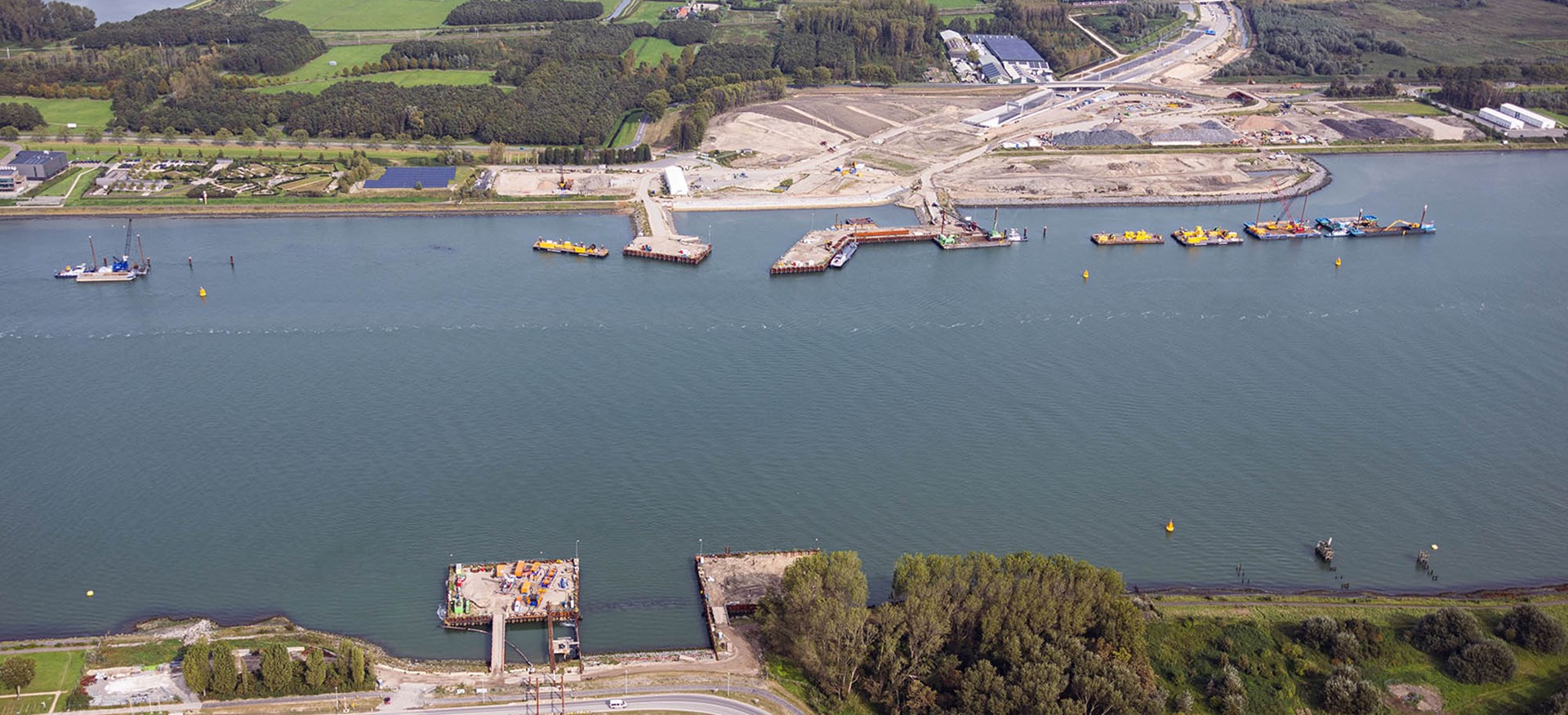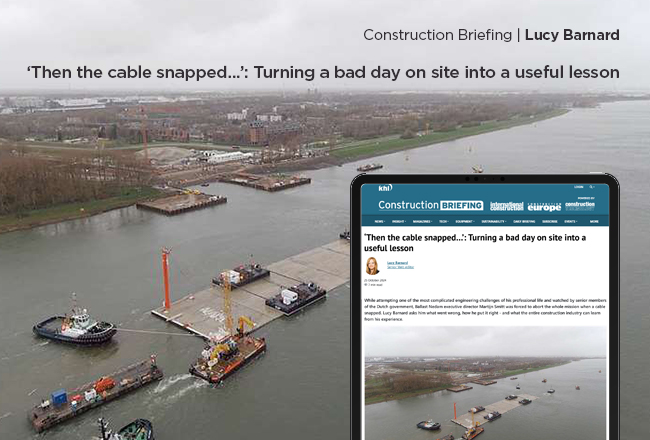‘Then the cable snapped…’: Turning a bad day on site into a useful lesson
While attempting one of the most complicated engineering challenges of his professional life and watched by senior members of the Dutch government, Ballast Nedam executive director Martijn Smitt was forced to abort the whole mission when a cable snapped. Lucy Barnard asks him what went wrong, how he put it right - and what the entire construction industry can learn from his experience.Everyone has bad days once in a while, but for Martijn Smitt, executive director at Dutch contractor Ballast Nedam, Saturday 29 April 2023, will go down as one of the worst.
Standing in a crowd of people on the banks of the River Scheur in Rotterdam, Smitt was on hand to oversee a reinforced concrete block the size of one of the tallest buildings in Europe, being carefully moved into position by tug boats as part of a €1 billion (US$1.1 billion) megaproject to upgrade infrastructure around Europe’s largest and busiest port.
“It was very exciting because of the size of the size and the scale of the project,” Smitt tells Construction Briefing. “It’s like a military operation. You have one person in charge, like a commander, but there’s a huge team around giving support – the project director, the board, the client and a huge group of experts.”
All eyes were focussed on the 185-meter-long block, known by the team as Isabella, which was to form the second and final element of an ambitious prefabricated reinforced Maasdeltatunnel concrete tunnel under the Scheur between Rozenburg and Massluis, which forms one of the busiest shipping lanes in the world.
In preparation for the installation, the Rotterdam Port Authority had agreed to close the port to shipping for a period of 30 hours and the Dutch minister for transport was receiving regular telephone briefings on progress.
“Very nervous indeed...”
“Some people got very nervous indeed,” says Sander Lefevre, a member of Ballast Nedam’s Board of Management, who was also part of the team. “Closing a port is not the usual thing we do in the Netherlands.”And then, with the eyes of the world upon it, just as the teams had carefully positioned the giant block and were starting the painstaking process of sinking it into the riverbed, one of the cables used to winch the block into place snapped.
“It was unfortunate,” says Smitt, with more than a touch of understatement. “The operation had to be aborted and postponed to another time frame.”
Instead of watching the final tunnel section sink into position, the watching crowds saw the tugboats slowly return it to the drydock where it had been manufactured four kilometres upstream while the Ballast Nedam team had the unenviable task of informing both the minister and the Port Authority of what had happened.

A unique experience
For Smitt, who has spent the last thirty years of an illustrious career working on prefabricated tunnels and describes himself on his Linkedin profile as an ‘immersed tunnelling addict,’ the snapping cable was unique in his experience.“I believe that in the Netherlands we have the most immersed tube tunnels in the world per square kilometre,” he says. “We already have more than thirty in the country, dating back to Europe’s oldest, the Maastunnel, in Rotterdam city centre which was started in the 1940s. And actually, we’re quite good at them.”
The technical challenge in this particular case, Smitt says arose from two unusual factors: Firstly, the Isabella tunnel section which the teams were attempting to float down the river, and its sister block Alara, were far larger than any previously made – a result of a redesign from an original proposal for six smaller tunnel sections by the Ballast Nedam team intended to reduce the number of disruptions to shipping. Secondly, the location where the tunnel was to be immersed was at a point in the river delta where both fresh river water and salty sea water mix, producing unpredictable currents.
Eventually, fresh 3d modelling revealed that the problem was likely to have arisen due to a density current produced by the layering of the different types of water. This itself had been taken into account by the computer model. However, the model had not accounted for the fact that a ditch had been dredged in the riverbed for the tunnel section to be lowered into, which changed the way the water flowed and caused stronger currents than expected.
“I myself did many calculations and we never saw such situation of fresh and saltwater layering,” Smitt says. “It was exactly on the location of the tunnel immersion that this layering occurred. Nowhere in the world had anyone ever had this situation.”
Smitt and his colleagues studied what went wrong carefully and went back to the drawing board to ensure that the next time they towed a tunnel section out into the river and lowered it into position, it would go off without a hitch.
“We changed the configuration to withstand these forces and checked again and again so failure was not an option,” Smitt adds. “We had thorough discussions with the expert team, did some additional model testing so that we were very sure that we understand the dynamics and the mechanisms. But it’s also a matter of using your own brains with that.”
And Smitt and Lefevre say the experience will ultimately help to inform further tunnel installations.
“No-one in the world had had this situation before,” Smitt says. “It was pretty new, and we can learn from that. Now we understand how to bring a better input to these models. This world of immersed tube tunnels is very small. We tend to exchange information with our colleagues around the world and explain what happened so that if anyone is in the same situation they know what to do.”
‘It shows what you get if you take responsiblity’
But having missed the original immersion date, finding another suitable time in which to again close the port of Rotterdam and in suitable weather and tidal conditions proved difficult.“We had several windows we couldn’t use because of the weather or because there was too much current. The weather we cannot influence too much, except for praying,” he says. “Finally, we got the right window in November [2023] which is of course potentially not the best season to do it. But, in the end, it went very smoothly.”
As a result, despite the nearly seven-month delay, Smitt and Lefevre say that the BAAK consortium, of which Ballast Nedam is a part, alongside dredging specialist DEME and UK-based infrastructure investor InfraRed, was able to complete the 945-metre-long tunnel and install a complicated set of new motorways and traffic intersections on time and on budget.
With the tunnel scheduled to officially open on 7 December 2024 and already used this summer as part of the women’s Tour de France Femmes cycle race, Smitt says that one of the things he is most proud of during the massive infrastructure project has been the way the consortium handled the situation.
“It shows what you get if you really take responsibility on the location instead of starting to discuss who whose fault it is and looking in the contract first,” he says. “In a very short time we communicated the problem to the government. It was all the way up to the top, as high as possible. They all supported the decision and that helped us also to first look into what happened and find the right solution - and then to schedule a new window with the Port Authority and the government. I think that is very valuable.”
“Looking back, we could have acted in a different way, but I am almost certain we would not be here having this interview now,” he adds. “Many civil engineering projects end up in legal battles. I think that’s one of the biggest achievements in this project is this very good cooperation with all the parties. That’s one thing we are very proud of.“
‘Logistical optimisation’
The new tunnel is part of Rotterdam’s new Blackenburgverbinding or A24, a five-kilometre-long, three-lane motorway which forms a connection between the A15 motorway near Rozenburg and the A20 between Maasluis and Vlaardingen.Construction started in 2018 under a public private partnership between Rijkswaterstaat, the Dutch ministry of public works, and water management and the BAAK consortium aims to improve traffic flows around the busy Rotterdam port area and improve access for emergency services.
“You could summarise it as a kind of logistical optimisation of the entire area,” Lefevre adds. “A huge amount of the imports and exports for the whole of Europe is going through that port so it really needs good infrastructure.”

Source: Lucy Barnard | Construction Briefing





